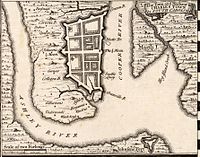
Queen Anne's War (1702–1713) was the second in a series of French and Indian Wars fought in North America involving the colonial empires of Great Britain, France, and Spain; it took place during the reign of Anne, Queen of Great Britain. In the United States, it is regarded as a standalone conflict under this name. Elsewhere it is usually viewed as the American theater of the War of the Spanish Succession. It is also known as the Third Indian War. In France it was known as the Second Intercolonial War.
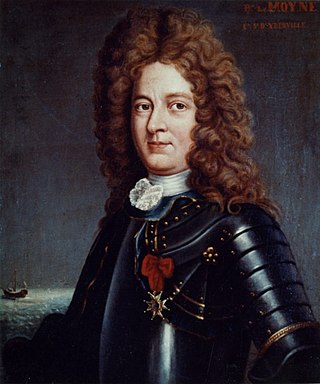
Pierre Le Moyne d'Iberville or Sieur d'Iberville was a French soldier, explorer, colonial administrator, and trader. He is noted for founding the colony of Louisiana in New France. He was born in Montreal to French colonist parents.

The American Revolutionary War saw a series of battles involving naval forces of the British Royal Navy and the Continental Navy from 1775, and of the French Navy from 1778 onwards. Although the British enjoyed more numerical victories, these battles culminated in the surrender of the British Army force of Lieutenant-General Earl Charles Cornwallis, an event that led directly to the beginning of serious peace negotiations and the eventual end of the war. From the start of the hostilities, the British North American station under Vice-Admiral Samuel Graves blockaded the major colonial ports and carried raids against patriot communities. Colonial forces could do little to stop these developments due to British naval supremacy. In 1777, colonial privateers made raids into British waters capturing merchant ships, which they took into French and Spanish ports, although both were officially neutral. Seeking to challenge Britain, France signed two treaties with America in February 1778, but stopped short of declaring war on Britain. The risk of a French invasion forced the British to concentrate its forces in the English Channel, leaving its forces in North America vulnerable to attacks.

Pedro Menéndez de Avilés was a Spanish admiral, explorer and conquistador from Avilés, in Asturias, Spain. He is notable for planning the first regular trans-oceanic convoys, which became known as the Spanish treasure fleet, and for founding St. Augustine, Florida, in 1565. This was the first successful European settlement in La Florida and the most significant city in the region for nearly three centuries.

The Battle of the Rice Boats, also called the Battle of Yamacraw Bluff, was a land and naval battle of the American Revolutionary War that took place in and around the Savannah River on the border between the Province of Georgia and the Province of South Carolina on March 2 and 3, 1776. The battle pitted the Patriot militia from Georgia and South Carolina against a small fleet of the Royal Navy.

Stede Bonnet was a Barbadian-born pirate and military officer, known as the Gentleman Pirate for the reason that he was a moderately wealthy landowner before turning to a life of crime. Bonnet was born into a wealthy English family on the island of Barbados, and inherited the family estate after his father's death in 1694. Despite his lack of sailing experience, Bonnet decided he should turn to piracy in the spring of 1717. He bought a sailing vessel, the Revenge, and travelled with his paid crew along the Eastern Seaboard of what is now the United States, capturing other vessels and burning other Barbadian ships.

Colonel William Rhett was an English-born planter, politician and military officer who immigrated to the Carolinas, where he spent the majority of his life. Born in London, Rhett emigrated to North America in 1694, accompanied by his wife Sarah. He gradually acquired ownership over several slave plantations which specialized in producing rice. Rhett also sat in the South Carolina General Assembly and served in the colonial militia; in 1718, he commanded two chartered sloops and defeated the Barbadian pirate Stede Bonnet in the Battle of Cape Fear River.

Spanish Florida was the first major European land claim and attempted settlement in North America during the European Age of Discovery. La Florida formed part of the Captaincy General of Cuba, the Viceroyalty of New Spain, and the Spanish Empire during Spanish colonization of the Americas. While its boundaries were never clearly or formally defined, the territory was initially much larger than the present-day state of Florida, extending over much of what is now the southeastern United States, including all of present-day Florida plus portions of Georgia, South Carolina, North Carolina, Alabama, Mississippi, and the Florida Parishes of Louisiana. Spain's claim to this vast area was based on several wide-ranging expeditions mounted during the 16th century. A number of missions, settlements, and small forts existed in the 16th and to a lesser extent in the 17th century; they were eventually abandoned due to pressure from the expanding English and French colonial settlements, the collapse of the native populations, and the general difficulty in becoming agriculturally or economically self-sufficient. By the 18th century, Spain's control over La Florida did not extend much beyond a handful of forts near St. Augustine, St. Marks, and Pensacola, all within the boundaries of present-day Florida.
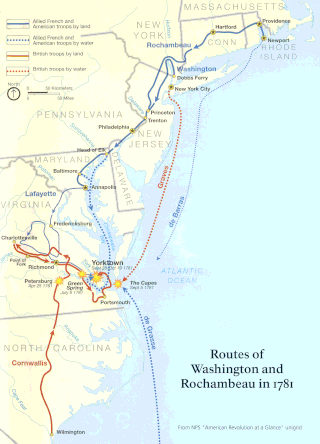
The Yorktown campaign, also known as the Virginia campaign, was a series of military maneuvers and battles during the American Revolutionary War that culminated in the siege of Yorktown in October 1781. The result of the campaign was the surrender of the British Army force of General Charles Earl Cornwallis, an event that led directly to the beginning of serious peace negotiations and the eventual end of the war. The campaign was marked by disagreements, indecision, and miscommunication on the part of British leaders, and by a remarkable set of cooperative decisions, at times in violation of orders, by the French and Americans.
The Battle of Thomas Creek, also known as the Thomas Creek Massacre, was an ambush of a small detachment of mounted Georgia Militia by a mixed force of British soldiers, Loyalist militia, and British-allied Indians on May 17, 1777 near the mouth of Thomas Creek in northern East Florida. The encounter was the only major engagement in the second of three failed attempts by American forces to invade East Florida in the early years of the American Revolutionary War.

The Apalachee massacre was a series of raids by English colonists from the Province of Carolina and their Indian allies against a largely peaceful population of Apalachee Indians in northern Spanish Florida that took place in 1704, during Queen Anne's War. Against limited Spanish and Indian resistance, a network of missions was destroyed; most of the population either was killed or captured, fled to larger Spanish and French outposts, or voluntarily joined the English.

The Battle of Kemp's Landing, also known as the Skirmish of Kempsville, was a skirmish in the American Revolutionary War that occurred on November 15, 1775. Militia companies from Princess Anne County in the Province of Virginia assembled at Kemp's Landing to counter British troops under the command of Virginia's last colonial governor, John Murray, Lord Dunmore, that had landed at nearby Great Bridge. Dunmore was investigating rumors of Patriot troop arrivals from North Carolina that turned out to be false; he instead moved against the Princess Anne militia, defeating their attempt at an ambush and routing them.

The Quebec expedition, or the Walker expedition to Quebec, was a British attempt to attack Quebec in 1711 in Queen Anne's War, the North American theatre of the War of Spanish Succession. It failed when seven transports and one storeship were wrecked and some 850 soldiers drowned in one of the worst naval disasters in British history.

The Burning of Norfolk was an incident that occurred on January 1, 1776, during the American Revolutionary War. British Royal Navy ships in the harbor of Norfolk, Virginia, began shelling the town, and landing parties came ashore to burn specific properties. The town, whose significantly Loyalist population had fled, was occupied by Patriot forces from Virginia and North Carolina. Although the Patriots worked to drive off the British landing parties, they did nothing to impede the progress of the flames, and began burning and looting Loyalist-owned property instead.

The siege of St. Augustine occurred in Queen Anne's War during November and December 1702. It was conducted by English colonists from the Province of Carolina and their Indian allies, under the command of governor of Carolina James Moore, against the Spanish colonial fortress of Castillo de San Marcos at St. Augustine, in Spanish Florida.

The siege of Port Royal in 1707 included two separate attempts by English colonists from New England to conquer Acadia by capturing its capital Port Royal during Queen Anne's War. Both attempts were made by colonial militia, and were led by men inexperienced in siege warfare. Led by Acadian Governor Daniel d'Auger de Subercase, the French troops at Port Royal easily withstood both attempts, assisted by irregular Acadians and the Wabanaki Confederacy outside the fort.
Francisco de Córcoles y Martínez was a Spanish military officer who served as governor of Spanish Florida, an office he occupied from 1706 to 1716.
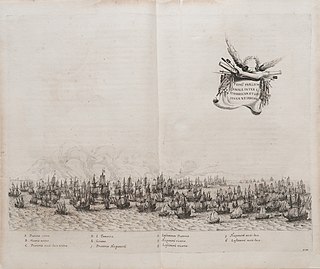
The action of 12–17 January 1640 was a naval battle between a Dutch fleet and a combined Spanish-Portuguese fleet during the Eighty Years' War. The battle took place on the Brazilian coast off Pernambuco and was an attempt by a fleet consisting of approximately eighty vessels transporting about 5,000 soldiers under the command of Portuguese Admiral Fernando de Mascarenhas to land reinforcements to bolster the Portuguese militia besieging the city of Recife. On 12 January this fleet was intercepted by a Dutch task force of about forty ships commanded by Willem Loos. The ensuing battle lasted with occasional breaks until the evening of 17 January, when the Spanish and Portuguese fleet retreated and sailed away to the north.
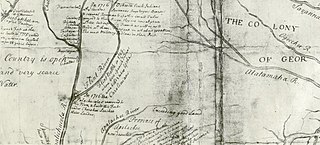
The Battle of Flint River, also called the Spanish-Indian Battle (1702), was a failed attack by Spanish and Apalachee Indian forces against Creek Indians in October 1702 in what is now the state of Georgia. The battle was a major element in ongoing frontier hostilities between English colonists from the Province of Carolina and Spanish Florida, and it was a prelude to more organized military actions of Queen Anne's War.

The siege of Pensacola included two separate attempts in 1707 by English-supported Creek Indians to capture the town and fortress of Pensacola, one of two major settlements in Spanish Florida.


